The complete, no-shortcuts guide for solopreneurs, marketers, and small teams
Read this first
If you’ve ever stared at a blank page and decided your idea was “bad,” you’re not alone. Most people kill their best work in that first, fragile moment. Here’s the twist: bad ideas are useful. They’re raw material. When you learn how to use AI creatively—with the right AI creativity prompts, structure, and iteration—you can shape those awkward sparks into names, hooks, content, and campaigns that actually land.
This article explains the concept from the ground up, using simple language and real examples. Then it gives you a complete AI Prompt Toolbox with two versions of every template:
- Pro (deep) — rigorous, structured, multi-step.
- Lite (fast) — quick viability checks when you’re short on time.
You’ll also see when to use which, common pitfalls, and what “good” output looks like.
Keywords you’ll naturally find here: AI creativity prompts, AI writing prompts, creative AI tools, prompt engineering, boosts creativity, solopreneur AI tools, generate ideas with AI, ChatGPT writing prompts, prompt templates, how to use AI creatively.
The idea: why “bad” ideas boost creativity
Let’s break it down in plain English.
- Bad ideas widen your field of view. Good ideas feel safe. Bad ones let you explore angles you’d normally censor. That wider search space is where breakthroughs hide.
- Constraints help, not hurt. A box gives you edges to push against. Tighter rules often produce better work.
- Collisions create surprise. The more your life bumps into different inputs—books, places, people—the more raw material you have.
- Incubation is real. Walks, showers, doing the dishes—your brain keeps working when you aren’t.
- Collaboration beats isolation. Even if you’re solo, you can simulate collaborators with ChatGPT writing prompts and persona-based feedback.
AI is perfect for this phase because it never gets tired, never gets offended, and can spin 50 variations in seconds. Your job is to direct it with good prompt engineering, then edit with taste.
The process at a glance
- Dump your messy idea. No judgment.
- Direct the AI with a template that adds context and constraints.
- Decide what’s promising. Keep 10–20% of outputs.
- Develop those winners with another round of prompts.
- Deliver and measure. Repeat what worked.
Now let’s open the toolbox.
The AI Prompt Toolbox
Purpose, outcomes, and two versions of every template
What this toolbox intends to do
- Give you repeatable structures so you can generate ideas with AI without getting generic mush.
- Move you from raw spark → reviewed idea → named asset → hooks → content → campaign.
- Work with any creative AI tools you prefer: ChatGPT, Claude, Gemini. Copy, paste, adjust, go.
For each tool, you’ll get: purpose, when to use, inputs, Pro Prompt, Lite Prompt, example, pitfalls, and metrics.
1) Collaboration Council
Get honest, multi-angle feedback—without hiring a panel
When to use
- You have something concrete: a landing page, ad, email, script, or deck.
- You need a sharp critique, not “looks good.”
- You’re preparing to ship or present.
Inputs
Asset type, audience, goal, content, or URL.
Pro Prompt (deep, original structure)
You are a feedback panel. Evaluate the following [ASSET TYPE: landing page/ad/email/script] for [AUDIENCE] with the goal of [GOAL].
Asset: [PASTE CONTENT OR URL]
Respond as three distinct personas:
1) Tastemaker (precision, restraint, design sense):
- 3 crisp critiques (clarity, visual priority, friction)
- 1 bold improvement
- Clarity score (1–10) and Why
2) Artist (emotion, story, voice):
- 3 critiques (tone, narrative hook, resonance)
- 1 image/metaphor that strengthens the message
- Emotional pull score (1–10) and Why
3) Skeptic (evidence, objections, BS radar):
- 3 critiques (proof, claims, risk)
- 1 “show me, don’t tell me” fix (social proof, demo, data)
- Proof score (1–10) and Why
Finish with:
- Top 5 fast edits (ranked)
- 1 bigger strategic recommendation (one paragraph)
- A 10-second summary for a stakeholder
Lite Prompt (fast triage)
Act as a three-voice reviewer (Clarity, Emotion, Proof).
For this [ASSET] aimed at [AUDIENCE] to achieve [GOAL], give:
- 3 must-fix issues
- 3 quick wins
- 1 sentence on the biggest risk
Asset: [PASTE]
Example output snippets
- Tastemaker: “Your headline competes with two CTAs. Merge them. Bold improvement: rewrite H1 as a promise, move secondary CTA below the fold.”
- Artist: “Metaphor: ‘Please hold… said no one ever again.’ That line gives your product a clear villain: waiting.”
- Skeptic: “Claim lacks proof. Add a 30-second demo or a customer stat before the first CTA.”
Pitfalls
- Too little context → generic critique.
- Asking for 10+ personas → noise. Stick to three.
Metrics to watch
- Edit list quality (can you act on it today?).
- Post-edit performance: clickthrough, scroll depth, reply rate.
When to use which version
- Pro for assets near launch.
- Lite when you’re still shaping the idea or moving fast.
2) Naming Engine
Produce 200+ viable names without weeks of meetings
When to use
- You’re naming a product, service, program, campaign, newsletter, or podcast.
- You need variety and rationale, not just a list.
Inputs
What it is, who it’s for, brand voice, taboos (e.g., “no blended words”), context (book cover, app icon, podcast tile).
Pro Prompt (deep)
You are a world-class naming strategist. Create names for:
Offer: [WHAT IT IS]
Audience: [WHO IT’S FOR]
Brand voice: [3 TRAITS]
Taboos: [e.g., no portmanteaus, no puns]
Context: [tagline, book cover, podcast tile—pick 1–2]
Round 1 — 30 names grouped by method (6 each):
- Descriptive (what it is)
- Metaphor (image/analogy)
- Conceptual (stance/idea)
- Foreign-inspired (include translation)
- Evocative single-word (real word, short)
- Invented (only if distinctive)
For each name:
- 1-line rationale (positioning + vibe)
- Tone fit (1–10)
- Memorability (1–10)
Ask me to pick 5 favorites.
Round 2 — 30 more, tightened by my feedback.
Reduce any method I rejected to <10%.
Provide quick conflict scan: “likely safe / might conflict / common phrase.”
Round 3 — Stress test top 10 in sentences (homepage H1, podcast tile, email subject).
Return 5 finalists + a decision matrix (distinctiveness, clarity, tone, extension).
Lite Prompt (fast list)
Generate 25 names for [OFFER] for [AUDIENCE] in a [TRAIT1-TRAIT2-TRAIT3] voice.
Split across Descriptive, Metaphor, Evocative.
One-line rationale each. Mark 5 best with ⭐.
Example flavor
For a modern marketing framework, the system might surface “Signal to Sale,” “Funnelcraft,” “Market Shift,” then test them in lines like:
- “Signal to Sale: modern marketing that measures what matters.”
Pitfalls
- Allowing the model to overdo blended words (“Marketix”). Cap them.
- Not testing in sentences. Names live in context.
Metrics to watch
- First-impression clarity (cold readers).
- Say-it-out-loud test.
- Basic conflict checks.
When to use which version
- Pro – When you need a final shortlist for stakeholders.
- Lite – When you’re exploring directions.
3) Messy Ad Writer
Hooks that actually stop the scroll
When to use
- Your ads sound like everyone else’s.
- You need volume first, polish later.
Inputs
Product, audience, primary outcome, tone, channel.
Pro Prompt (deep)
You are an ad creative partner. Create scroll-stopping hooks for:
Product: [WHAT IT DOES]
Audience: [WHO]
Outcome: [PRIMARY BENEFIT]
Tone: [e.g., helpful, witty, confident]
Channel: [Meta Ads/YouTube/LinkedIn]
Generate 48 hooks:
A) Benefit punches (12)
B) Specific outcomes / numbers (12)
C) Pattern interrupts / humor (12)
D) Emotional truth / relief (12)
Rules:
- 6 words max for half of them
- No buzzwords
- 1 clear idea per line
- Vary rhythm, avoid repeats
Then:
- 6 ad variants (short primaries + bodies) in the selected tone.
- A/B/C test set with distinct angles.
- 5 “weird but safe” alternates.
- Optional: a 90-second voiceover script.
Lite Prompt (fast list)
Write 20 short ad hooks for [PRODUCT] to [OUTCOME] for [AUDIENCE], tone [TRAITS].
Keep half under 6 words. No jargon.
Example lines inspired by the talk
- “Please hold… said no one ever again.”
- “Press 0 for instant happiness.”
- “Your backlog’s about to vanish.”
Pitfalls
- One tone only → flat list. Ask for varied angles.
- Over-specific claims without proof. Pair with social proof.
Metrics to watch
- Hook CTR, thumb-stop rate, view-through.
- Comment sentiment on playful hooks.
When to use which version
- Pro for structured testing and multi-angle creative.
- Lite for a quick refresh.
4) Square Peg Content Engine
Ideas people actually want to share
When to use
- Your calendar feels safe and same-ish.
- You want memorable angles that still tie to value.
Inputs
Brand, audience, topic pillar, voice.
Pro Prompt (deep)
You are a content strategist. Generate bold ideas for:
Brand: [WHO YOU ARE]
Audience: [WHO THEY ARE]
Topic pillar: [THEME]
Voice: [3 TRAITS]
Produce 24 ideas across three tiers (8 each):
- Safe but strong
- Clever twist
- Wild but workable
For each idea:
- Title (headline-ready)
- 1-sentence “why it’s interesting”
- Best format (reel, thread, article, carousel)
- 3-beat outline (Hook, Payoff, Proof/How-to)
- “Remix it” note (platform or audience switch)
End with:
- A 4-week content arc (2 posts/week) mixing the best ideas
- 5 hooks for Post #1 in different tones (plain, witty, direct, urgent, curiosity)
Lite Prompt (fast angles)
Give me 12 content ideas for [TOPIC] for [AUDIENCE] in a [VOICE] voice.
Split evenly across Safe/Clever/Wild. Include title + one-line angle + format.
Example angles from the conversation
- “Your horoscope, but it’s a tree.”
- “We asked three toddlers and a golden retriever to review our garden.”
- “100% honest FAQs: Will I get lost? Yes—and it’s glorious.”
These sound whimsical, but they teach something memorable.
Pitfalls
- Wild without a “why.” Every idea needs a useful payoff.
- Ignoring brand fit—keep the voice traits in view.
Metrics to watch
- Saves, shares, repeat visitors, subscriber growth.
When to use which version
- Pro for building a month of differentiated content.
- Lite for ideas spark for this week.
5) Bad Idea Campaign Generator
Start wild, then tame it into something shippable
When to use
- You want a campaign that stands out.
- Brainstorms have gone in circles.
Inputs
Offer, audience, goal, guardrails.
Pro Prompt (deep)
You are a senior brand strategist. Create a bold campaign concept for:
Offer: [WHAT]
Audience: [WHO]
Goal: [AWARENESS/LEADS/SALES]
Guardrails: [LEGAL/BRAND LIMITS]
Step 1 — 12 starters across 4 types (3 each):
- Obvious (say it loud)
- Absurd (delightfully wrong)
- Contrarian (flip the norm)
- Logistically wild (nearly impossible)
For each:
- Campaign name
- One-sentence pitch
- Emotional trigger (relief, pride, FOMO, rebellion)
- One visual (thumbnail/poster idea)
Step 2 — Tame It:
- Convert each into a brand-safe version (same core, practical execution)
- Add Risk / Effort / Impact score (1–10)
Step 3 — Launch Lite:
- A 2-week smoke test plan (channels, creative, offer)
- Pre-mortem: top 5 failure points + mitigations
- One metric that matters per channel
Lite Prompt (quick spark)
Give me 8 bold campaign starters for [OFFER] to [GOAL].
Label each as Obvious / Absurd / Contrarian / Wild.
Add one brand-safe version per idea.
Example starters from the talk
- “Survive the Simulation.” Wild immersive challenge → tame to a high-stakes case-study sprint.
- “Degree in a Box.” Mail everything at once → tame to a pre-semester starter kit.
- “Campus Bonfire of the Vanities.” Symbolic ritual → tame to “retire your old resume” kickoff.
- “Wisdom for Night Owls.” Everything at midnight → tame to late-hours webinar series.
Pitfalls
- Shipping the wild idea without taming. Use the scoring.
- No pre-mortem. List the likely failures before you launch.
Metrics to watch
- Distinctive recall (do people remember it?), assisted conversions, and earned mentions.
When to use which version
- Pro for planning serious campaigns.
- Lite to jolt your team out of creative ruts.
End-to-end example (so you can see the flow)
Raw spark (looks “bad”):
“Launch our support agent with the line ‘Our robot beat you to the phone.’”
Step 1 — Collaboration Council (Pro)
- Tastemaker: tighten the headline, move proof higher.
- Artist: “Please hold… said no one ever again” as the hero line.
- Skeptic: Show a 30-second demo and a backlog reduction stat above the fold.
Top 5 edits delivered. You implement three today.
Step 2 — Naming Engine (Lite)
- Variations for the launch theme: “Holdless,” “Zero Hold,” “Instant Answers,” “Signal to Support.”
- Two-pass initial clarity tests. You keep “Instant Answers.”
Step 3 — Messy Ad Writer (Pro)
Best hooks scored in tests:
- “Please hold… said no one ever again.”
- “Press 0 for instant happiness.”
- “Your backlog’s about to vanish.”
Step 4 — Square Peg Content Engine (Lite)
- “We measured how many hours ‘Please hold’ steals each week.”
- “Behind the scenes: training the agent that never sleeps.”
Step 5 — Bad Idea Campaign (Pro)
- Wild: “24-hour ‘Hold Music’ funeral.”
- Tame: “Hold Music Amnesty Day” with a counter of minutes saved and real customer shout-outs.
- Launch the Lite plan set for two weeks.
You’ve moved from a “maybe bad” line to a named theme, ads that test well, content with a hook, and a campaign concept that’s both surprising and safe to ship.
Quick recipes
- Five-minute rescue: Lite Collaboration Council → fix 3 things → publish.
- Thirty-minute tune-up: Lite Council → Lite Messy Ad Writer → pick 3 hooks → ship.
- Ninety-minute build: Pro Council → Lite Naming → Pro Ad Writer → Lite Square Peg → schedule campaign brainstorm.
FAQ
Will AI make my work generic?
Only if you take the first pass. Iterate. Ask for different tones, angles, and constraints.
How do I keep my brand voice?
Give 3–5 voice traits and a “do/don’t” pair. Ask the model to “punch up in this voice.” Always do a human polish.
What if I hate invented names?
Say so in the prompt. Cap “invented” to 0–10%. Bias toward descriptive or evocative real words.
Which model should I use?
Any strong general model works. For hooks and headlines, push it for personality and specificity.
Final word
Bad ideas aren’t the enemy. They’re the door. With intentional prompt templates, smart prompt engineering, and steady iteration, you can boost creativity on demand—whether you’re a team of one or running a department. Use the Pro versions when quality matters and you’re close to shipping. Use the Lite versions when you need speed.
If you want a deeper dive into the mindset behind all this, Jason Keath’s The Case for More Bad Ideas is a solid companion. Pair it with this toolbox and you won’t stall at the blank page again.
Now it’s your turn: pick one rough idea from your notes, drop it into the Collaboration Council (Pro), and take the first edit it recommends. Then keep going.
📚 Take Your AI Prompt Skills to the Next Level
If you enjoyed learning how to turn bad ideas into brilliant AI prompts, you’ll love my exclusive eBook — a curated collection of premium prompt templates, real-world use cases, and insider tips to help solopreneurs, marketers, and small business owners unlock unstoppable creativity.
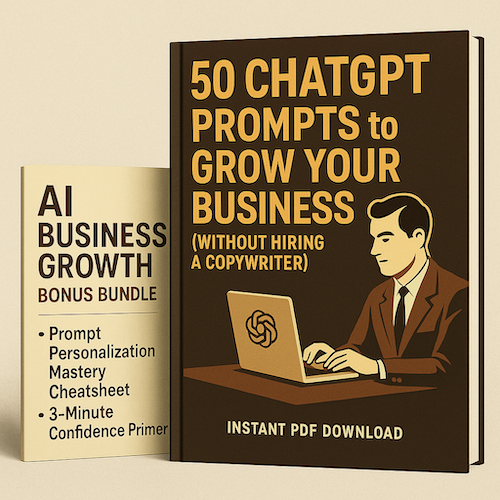
50 ChatGPT Prompts to Grow Your Business
(Without Hiring a Copywriter)
Feel seen. Sound sharp. Ship faster. This isn’t just a prompt list — it’s an emotional clarity engine built for solopreneurs who want to write, sell, and show up without overthinking.
- 50 role-based, long-form prompts for sales, emails, social, websites, offers, and SEO
- Bonus #1: Prompt Personalization Cheatsheet
- Bonus #2: 3-Minute Confidence Primer
- Instant PDF download — start using today
7-Day “Love it” Promise — full refund if you’re not thrilled
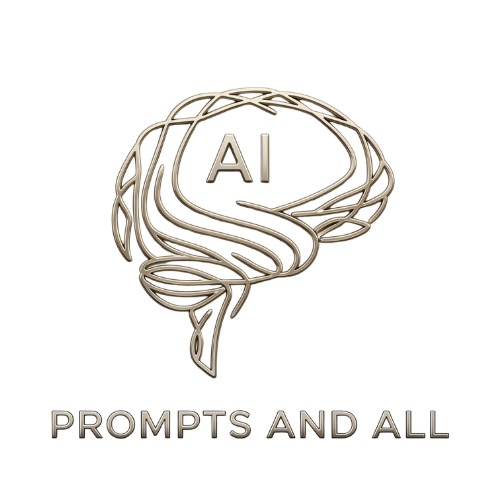


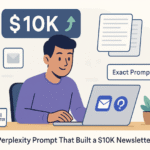
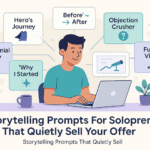

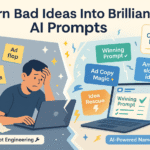

Recent Comments